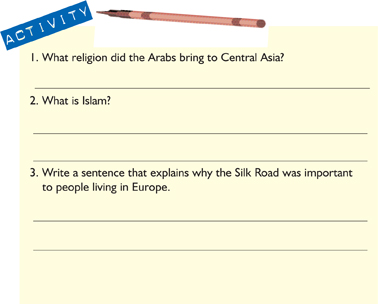How Has History Affected the People of Central Asia?
Who Are the People of Central Asia?, What Is Central Asia Like Today?
Over a thousand years ago, traders made land routes across Central Asia. These routes connected important cities from China to the Black Sea. They helped spread goods and ideas between Asia and Europe. Camels and horses carried one of the main products— Chinese silk. Traders also carried porcelain, Persian silver, and Indian spices. By A.D. 100, the Silk Road connected China in the east with the Rome Empire in the west.
From about A.D. 700 the Arabs ruled Central Asia. They brought Islam to the area. Islam is a religion founded by a man named Muhammad. Muhammad's followers are known as Muslims. The religion is based on the messages that Muhammad received from God. The Arabs built beautiful mosques, or buildings, for Muslim prayer. They brought architecture and art to Central Asia.
Because this region is so dry, crops are difficult to grow. Families raised animals for food and money. They grazed herds on grasslands called steppes. Steppes are huge treeless grasslands. They are often found on the edge of deserts.
By 1220, Mongol armies rode into Central Asia. The steppes supplied food for their horses. The Mongols conquered the region. They destroyed the Arab culture.
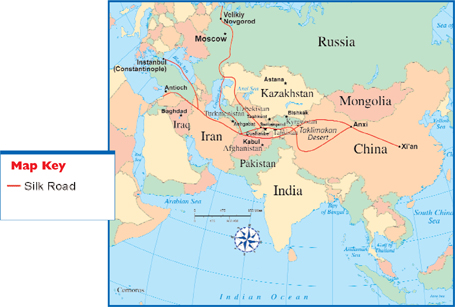 Silk Road Routes
Silk Road Routes
Who Are the People of Central Asia?
Look at the map on page 84. Look for Kazakhstan (kuh-zahk-stahn) that borders the Caspian Sea. Now find Turkmenistan (turhk-men-nuh-stan). Go east and find Kyrgyzstan (kihr-gih-stan), Tajikistan (tah-jih-kih-stan), and Uzbekistan (uz-beh-kih-stan). Go south and find Afghanistan (af-ga-nuh-stan). They make up Central Asia. Many ethnic groups live in the region. Each country is named for the largest group that lives there. The word stan means “the land of.” For example, Kazakhstan means “the land of the Kazakhs.” The Arabs, Mongols, and Soviets all had a great influence on Central Asia.
What Is Central Asia Like Today?
The Soviet Union controlled Central Asia from 1917 until 1991. They divided the land into republics. Each country was a satellite nation of the Soviet Union. A satellite nation is a country in which the economy and government are controlled by another more powerful nation. Central Asia's resources benefited the Soviet Union.
In Afghanistan, the Taliban, a radical Muslim group, still fights for control of the country. The United States and British forces attacked the Taliban after the September 11, 2001, terrorist attacks on New York and Washington, D.C. The war continues.
Most countries in Central Asia face environmental, political, and economic challenges. Irrigation has taken so much fresh water from the rivers that almost no water reaches the Aral Sea. It is drying up. Although Central Asia has large amounts of oil, they will need help to develop this resource.
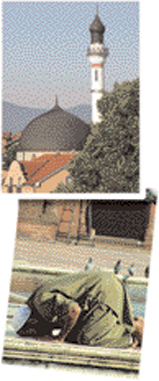 A mosque
A mosque
A Muslim man praying in an open Mosque
How Has History Affected the People of Southwest Asia?
Look at the map of Southwest Asia below. Find an area of land shaped like a crescent, or half circle. This is the Fertile Crescent. It begins at the Mediterranean Sea. Then stretches between the Tigris (ty-gruhs) and Euphrates (yooh-fray-teez) rivers. It ends at the Persian Gulf.
About 8000 B.C., the first civilization began here. A civilization is a society that has buildings and grows food. It also has a central government. The soil in the Fertile Crescent was rich. There was water and wild grains. Nomads began to settle along the riverbanks. They became the world's first farmers. As the population grew, farmers needed water for crops. They built irrigation systems. They developed ways to collect water and bring it to the crops. Soon, settlers built towns to protect themselves.
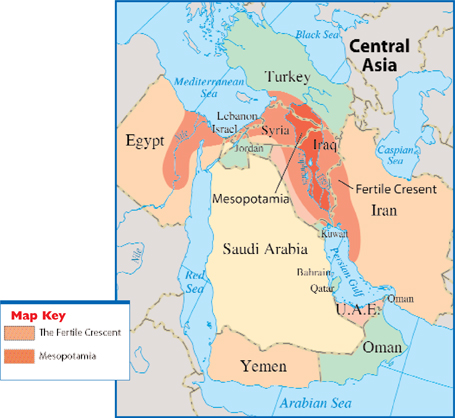 Southwest Asia and the Fertile Crescent and Mesopotamia
Southwest Asia and the Fertile Crescent and Mesopotamia
Find Mesopotamia on the map. By 3000 B.C., a people called Sumerians (soo-mer-ee-unz) settled in a land called Sumer (soo-muhr). They built ziggurats (zih-guh-ratz), great temples to their gods. Sumerians invented cuneiform (kyoo-nee-fohrm), the world's first written language. The Sumerians used a sharp tool to mark wedge-shaped forms in wet clay tablets. The tablets were then baked. They recorded information about everyday life. The Sumerians were also traders. They exchanged their grain, pottery, and hand tools for metal.
Because of the rich soil, water, and transportation routes, Mesopotamia faced many wars and invasions by other groups.
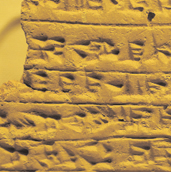 Cuneiform, an ancient language, carved in a clay tablet.
Cuneiform, an ancient language, carved in a clay tablet.
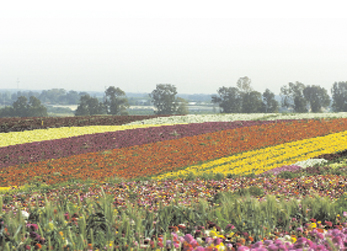 Flowers growing in the Fertile Crescent.
Flowers growing in the Fertile Crescent.
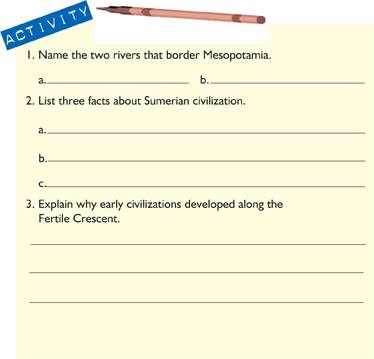
Who Are the People of Southwest Asia—the Middle East?
Look at the map on page 86. Most of the people in Southwest Asia are Arabs. They speak Arabic and follow Islam. Kurds are another large ethnic group. Jews make up another cultural group. They speak Hebrew. Their religion is called Judaism. Judaism (joo-dee-i-zuhm) is the Hebrew people's religion. Three world religions have their roots in Southwest Asia—Judaism, Islam, and Christianity.
Arabs are very private. Many Arab women wear a long black dress called an abayah (ah-buy-yah). It covers them from the shoulders to their feet. Some women also cover their head and face. Most men wear a loose robe. It helps keep them cool in hot weather. A red and white cover protects their head from the sun. It is also used to cover the nose and mouth during sand storms.
Arabs have many customs and traditions based on their religion. For example, Muslims fast (a period of time when a person does not eat) during their holy month of Ramadan.
Israel became a country in 1948. About 80 percent of the people in Israel are Jews. They have lived in the region for more than 2,000 years. After being persecuted in Europe for many years, the Jews wanted a homeland. During the 1930s and 1940s, over six million Jews and other people were victims of the organized massive killing of people known as the Holocaust. After all this suffering in Europe, and in other parts of the world, the Jews wanted their own nation.
The other 20 percent are an Arab people called Palestinians. Palestinians are Muslims, but some are Christians. Both Jews and Palestinians believe that they own the land. They continue to fight over who owns the land in Israel.
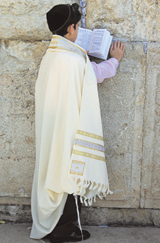 A young Jewish boy praying at the Western Wall, sometimes referred to as the Wailing Wall.
A young Jewish boy praying at the Western Wall, sometimes referred to as the Wailing Wall.
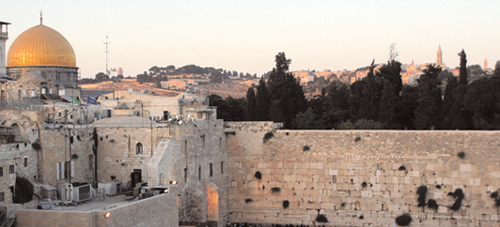 A view of the Temple Mount in Jerusalem, Israel, including the Western Wall and the golden Dome of the Rock.
A view of the Temple Mount in Jerusalem, Israel, including the Western Wall and the golden Dome of the Rock.
What Is Southwest Asia Like Today?
In 1945, several Arab countries formed the Arab League. They decided to work together to improve their region. They improved education. The Arab League is not like the European Union. It does not have free trade or use the same money.
The countries of Central and Southwest Asia have almost 60 percent of the world's oil. Saudi Arabia has about 22 percent of the world's total. Many people have jobs in the oil and gas industries. They enjoy a high standard of living. Everyone receives free education and health care.
Turkey has a majority Arab population. In the 1930s, modern Turkey was founded. Turkey prides itself on being a democracy. It is not controlled by any religious group. The people have many freedoms, such as religion, free speech, and a free press. It has recently taken steps to make many reforms to strengthen its democracy and economy so that it can join the European Union.
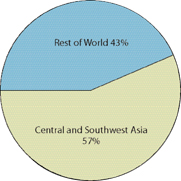 Where is the Oil?
Where is the Oil?
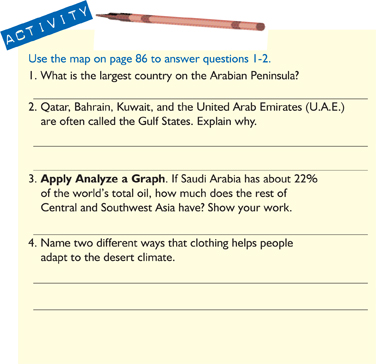
Additional topics
- How Has History Affected the People of Southeast Asia? - Who Are the People of Southeast Asia?, What Is Southeast Asia Like Today?
- How Has History Affected the People of East Asia? - Who Are the People of East Asia?, What Is East Asia Like Today?
- Other Free Encyclopedias
History Reference: Ancient History & World HistoryThe Eastern Hemisphere - Asia

